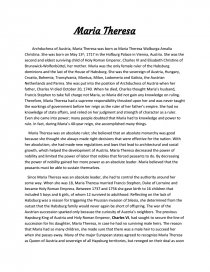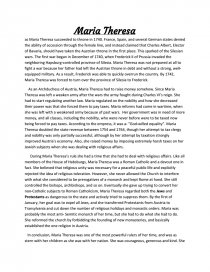Maria Theresa
Essay by ptruong • November 29, 2015 • Essay • 1,147 Words (5 Pages) • 1,542 Views
Archduchess of Austria, Maria Theresa was born as Maria Theresa Walburga Amalia Christina. She was born on May 13th, 1717 in the Hofburg Palace in Vienna, Austria. She was the second and eldest surviving child of Holy Roman Emperor, Charles VI and Elisabeth Christine of Brunswick-Wolfenbüttel, her mother. Maria was the only female ruler of the Habsburg dominions and the last of the House of Habsburg. She was the sovereign of Austria, Hungary, Croatia, Bohemia, Transylvania, Mantua, Milan, Lodomeria and Galicia, the Austrian Netherlands and Parma. She was put into the position of Archduchess of Austria when her father, Charles VI died October 20, 1740. When he died, Charles thought Maria’s husband, Francis Stephen to take full charge not Maria, so Maria did not gain any knowledge on ruling. Therefore, Maria Theresa had a supreme responsibility thrusted upon her and was never taught the workings of government before her reign as the ruler of her father’s empire. She had no knowledge of state affairs, and relied on her judgment and strength of character as a ruler. Even she came into power; many people doubted that Maria had to knowledge and power to rule. In fact, during Maria’s 40-year reign, she accomplished many things.
Maria Theresa was an absolute ruler; she believed that an absolute monarchy was good because she thought she always made right decisions that were effective for the nation. With her absolutism, she had made new regulations and laws that lead to architectural and social growth, which helped the development of Austria. Maria Theresa decreased the power of nobility and limited the power of labor that nobles that forced peasants to do. By decreasing the power of nobility gained her more power as an absolute leader. Maria believed that the peasants must be able to sustain themselves.
Since Maria Theresa was an absolute leader, she had to control the authority around her some way. When she was 18, Maria Theresa married Francis Stephen, Duke of Lorraine and became Holy Roman Empress. Between 1737 and 1756 she gave birth to 16 children that included 5 boys and 6 girls, of whom 12 survived to adulthood. Reflecting on the lack of Habsburg was a reason for triggering the Prussian invasion of Silesia, she determined from the outset that the Habsburg family would never again be short of offspring. The war of the Austrian succession sparked only because the curiosity of Austria’s neighbors. The previous Hapsburg King of Austria and Holy Roman Emperor, Charles VI, had sought to secure the line of succession for his daughter, Maria Theresa, in case he had no surviving male heirs. The reason that Maria had so many children, she made sure that there was a male heir to succeed her when she passes away. Many of the major European states agreed to recognize Maria Theresa as Queen of Austria and sovereign of all Hapsburg territories, but reneged on their deal as soon as Maria Theresa succeeded to throne in 1740. France, Spain, and several German states denied the ability of accession through the female line, and instead claimed that Charles Albert, Elector of Bavaria, should have taken the Austrian throne in the first place. This sparked of the Silesian wars. The first war began in December of 1740, when Frederick II of Prussia invaded the neighboring Hapsburg-controlled province of Silesia. Maria Theresa was not prepared at all to fight a war because her father had left the Austrian throne in debt and without a strong, well-equipped military. As a result, Frederick was able to quickly overrun the country. By 1742, Maria Theresa was forced to turn over the province of Silesia to Frederick.
...
...


